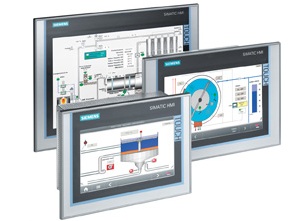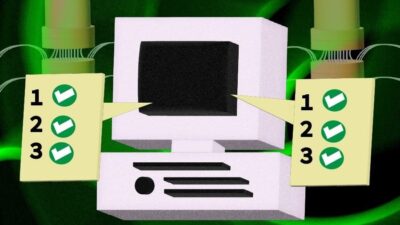Choices of controllers that include an integrated HMI in one package are growing. These promise greater simplicity if the combination of elements works in your situation.

Here’s a common situation: You need to find a new TV and DVD player for your home entertainment system. At your local big box retailer you find lots of individual components and a few offerings that incorporate all the parts into one unit. Which do you choose? An all-in-one package is convenient, uncomplicated, and minimizes the size of the system, but may not offer all the features or flexibility of individual components. Maybe you want a Blu-ray player but it’s not available. Now, change the circumstances and make the same selection for your conference room at work. Does a different application cause you to make a different choice?
If you are working on an application that will require selecting a PLC and HMI (human-machine interface) to control a machine or part of a process unit, you might go through the same thought process. While the controller and interface traditionally would have been separate items, increasing processor power combined with lower electronics costs make it practical to offer integrated PLC/HMI units in one package. These can offer a high level of simplicity and convenience in the right applications, but they aren’t suitable for everything.
Combination units typically include a range of elements:
- HMI, including a display that is probably a touchscreen plus separate buttons
- PLC, with an appropriate level of processor power and functionality, and
- I/O, with appropriate numbers and types. Some offer expandability using additional add-on modules.
Proponents of such designs make the point that they are very convenient and minimize the amount of cabling and cabinet space. All the wiring goes to one point to simplify troubleshooting. Even the software is simpler in that there does not need to be separate programming for the PLC and HMI.
“When you have the PLC and the HMI all built into one, you only need one piece of programming software to program both the PLC functionality and the HMI functionality,” says Sam Schuy, engineering manager, Maple Systems, Inc. “So from the standpoint of the learning curve, it shortens the amount of time required to learn how to use and program the product.”
A limited selection
Like finding a combination TV and DVD, your choices in an integrated unit will be far more limited than individual components. Consequently, your ability to enjoy the convenience will depend on whether your application can operate within those constraints. For supplier companies that want to offer such products, it’s a matter of determining which combination of capabilities will be the most universal and therefore marketable. One size does not fit all, but manufacturers like to keep the number of product variations as low as possible. Since those selections are driven by applications, it can come down to choosing particular markets. For example, if you are aiming at packaging machinery, you can identify common needs and fulfill those.
“It’s a matter of knowing the market that you’re trying to address with an integrated unit. If you say, ‘These are the OEMs and applications where we’re going to go,’ they will sell like popcorn,” says Tom Elswick, manager of the product management group, automation systems factory automation for Siemens Industry. His experience said that the hardest combination to get right was the CPU and display. For general applications, it was easier to integrate I/O with the CPU and make the HMI separate.
Elswick adds, “With the I/O and CPU built together we have a much better hit-rate of meeting the application. We allow the customer to say, ‘I want a 15-in. screen,’ or ‘I want a 10-in. screen.’ That was the mix piece that we struggled with. For certain people, we hit the sweet spot, and it was great. But from a broad-based standpoint, typically the amount of I/O, the type of I/O, and the type of CPU is a much closer correlation. With the HMI, you might have a very powerful CPU, but you really want a small HMI because you’re connecting with a SCADA system where it’s doing more of the bigger-picture processing. Or, you want a lower-end CPU without much I/O or much functionality, but you want a really nice graphical front end with lots of diagnostics and functionality.”
Convenient yes, but a good idea?
There are conceptual issues with an integrated platform that make some users uncomfortable. “Most people, when they look at their PLC, they see it as dedicated to safe, efficient, and effective control. That’s it,” says John Krajewski, director of product management for HMI supervisory, Invensys Operations Management. “They don’t want it doing anything else, and they don’t want there to be other functions bringing down that performance, particularly when it relates to safety. If you have a common CPU, and you start doing things in the HMI that start utilizing that CPU so that it’s no longer available for control, that can be a bad situation. You don’t want people using it to make calls to a database that could have the CPU very busy for a time, when it’s also responsible for ensuring that it’s going to be doing interlocks that are responsible for safety. That’s been the common argument against bringing them together.”
Krajewski acknowledges that potentially hazardous applications probably won’t use an integrated solution to begin with, given the complexity of those systems, but the same idea could apply to discrete manufacturing situations that depend on fast response from the PLC.
Who’s using the HMI?
Integrated units typically have modest screen sizes, although product offerings are evolving. To a large extent that is driven by the expectation of where such equipment will be deployed. A skid that is built with a pump, strainer, flowmeter, and control valve for installation in a larger process unit will almost certainly be connected to a larger control system and operated from a central control room. A human operator may only interface with the skid’s HMI when there is a problem, so elaborate graphics would rarely be enjoyed.
On the other hand, in some applications, such as packaging or food and beverage plants, a local operator may be working with that device almost constantly. Krajewski explains, “If you’re in an industry like food and beverage, it’s much more common to have operators right there because they will need to add material or make sure everything is moving forward, so they tend to be more co-located with the equipment. Other areas it may not be practical. If you think about water and wastewater, there may be many miles between systems.”
Appealing costs for OEMs
Siemens’ Elswick says that most of the purchasing activity he’s seen on integrated units comes from OEM accounts that are serving discrete industries, or discrete applications in process environments. “They’re building a specific piece of equipment, and there’s a definite purpose,” he says. “An OEM thinks, ‘I’m going to build 200 of these this year. I know what my I/O looks like, I know how many I/O points, and I know what my screens look like.’ That’s when this kind of device fits perfectly with the right price and performance ratio.”
While all types of users are cost conscious, OEMs have to be especially aware of how much cost any component or manufacturing step adds to a product. An integrated unit offers a very effective way to avoid the labor costs related to mounting a larger number of components and buying those items. A single unit can be installed more quickly, probably in a smaller enclosure, and avoid the need for additional cables and accessories.
“When you look at how an OEM prices up a machine, they’re going to count every little item, every cable, every wire tray, everything that they have to do, because they all add to the cost,” Krajewski says. “At the end of the day, it’s the economics that drive these decisions.”
The limits of practicality
As mentioned earlier, integrated units tend to be at the lower end of the functionality spectrum. As applications move into higher I/O counts and greater programming complexity, the practicality of offering an off-the-shelf unit that fits such an application is much smaller and suppliers don’t see the benefit. Still, some producers feel they have yet to see the full extent of the market.
Schuy believes there is still room to expand the product line. Maple Systems’ initial integrated offerings have used relatively small screen sizes of 3.5- and 5.7-in., while the company’s separate HMIs go as high as 15-in. New integrated units with 7- and 10-in. screens are being evaluated, but he thinks those are pushing useful limits. “Once you get into the larger screens, the cost difference between conventional components and a combination HMI/PLC gets closer together,” he says. “The majority of the cost is in the display itself. That’s the most expensive part. If a customer wants a larger screen, say 10-, 12-, or 15-inch, they’re probably going to go ahead and do it separately.”
I/O options are also limited. A user that wants to install a system in a process manufacturing plant using smart instrumentation via HART or a fieldbus network will find few if any integrated options. The greater availability of I/O for discrete sensors reflects the slant toward discrete applications.
Other types of integration
As Elswick already mentioned, Siemens finds it easier to integrate I/O and a PLC without the HMI. Invensys and Siemens both see growing opportunities for integration of HMIs with PC-based controllers rather than more traditional PLCs. Krajewski reports more OEMs are asking for HMIs that can be laid on top of those controllers, now that technology has caught up with the concept of using soft PLCs. “We had entered the PC-based control market back in the late 1990s with the Wonderware InControl product, and at that time it was too early. There weren’t embedded operating systems and those kinds of things. Back then we were talking about Windows 95 and 98, and people didn’t trust those for control.”
Evolving technologies are going in a wider variety of directions than ever before, so users can select an offering precisely aligned with the needs of a given application. The greatest challenge is often sifting through the dizzying range of choices.
– Peter Welander is a content manager for Control Engineering. Reach him at pwelander(at)cfemedia.com.
https://www.controleng.com/hmi



